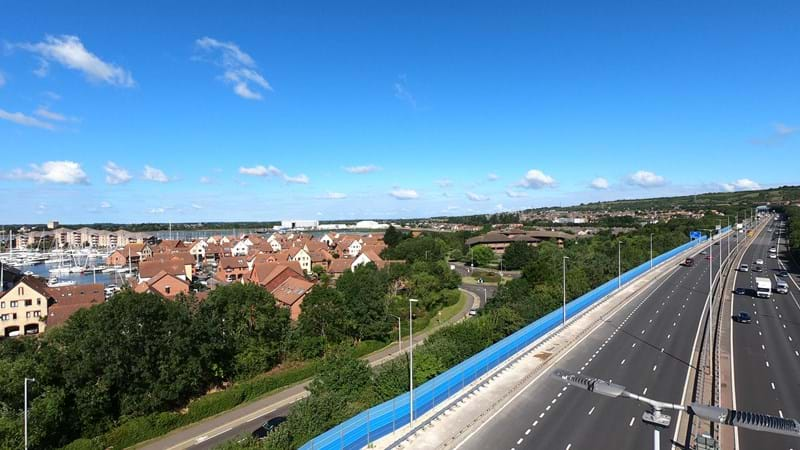Noise
We want to do all we can to look after the wellbeing of everyone who uses our roads and lives or works near them by making a difference when it comes to noise

We know that noise from vehicles using our roads affects people’s peace and comfort, as well as posing risks to their health and wellbeing.
We now build measures into the newer parts of our network to control noise and install noise mitigation measures as standard on our road schemes.
However, many of the older sections of our network were built to older standards when noise was less of a concern.
We recognise that there are opportunities for us to install more noise mitigation measures in these locations.
Our Environment and Wellbeing Designated Fund helps us make the most of these opportunities. The fund encourages us to work in an environmentally responsible way, allowing sustainability to shape our work from start to finish.
Our research programme helps us invest the fund wisely, to achieve real improvements for people most affected by high noise levels.
How we reduce noise
We have a number ways to reduce noise in our new schemes or existing roads:
Road surface
On high speed roads, most noise comes from vehicle tyres on the road surface.
Changing to low-noise road surfaces can make a big difference to the noise level.
Over recent years we've installed low-noise surfaces as standard on new roads and on existing roads when they need resurfacing.
We use Designated Funds for resurfacing in areas which have high noise levels.
Noise barriers
Noise barriers are fences that we build between roads and nearby houses.
They work by blocking the path of noise from vehicles and are very effective at reducing noise in areas close to roads.
They are less effective further away (more than 100 metres) from a road.
Our noise barriers are made from a variety of materials, including wood, plastic, concrete and steel.
Noise insulation
Where we can't install noise barriers, we can insulate houses to reduce the noise that people are exposed to.
Insulation packages can reduce noise in the rooms where people spend most of their time. Packages may include upgrades to windows and ventilation systems.
Designated funding for noise mitigation
The government has given us ring-fenced funding specifically for noise reduction to protect the health of our neighbours, through what are known as Designated Funds.
The Department for Environment Food and Rural Affairs (Defra) has identified locations experiencing the highest noise levels as part its Noise Action Plan: Roads.
These areas have been designated as Noise Important Areas (NIAs)
Our noise mitigation policy
We're using our Environment and Wellbeing Designated Fund to provide noise mitigation in NIAs, but there are more NIAs than we have funds to mitigate.
This is how we prioritise which NIAs will receive mitigation from Designated Funds, through Roads Period 2 (RP2) (2020-2025).
We can declare new NIAs, or extend NIAs to include additional properties. We'll only do this if noise levels are similar to noise levels in other NIAs.
We can't use Designated Funds for NIAs that aren't prioritised, or locations that don't fall into NIAs. However, we can provide noise mitigation through our road maintenance and improvement schemes.
Prioritising Noise Important Areas
We have identified NIAs that would get noise benefit from resurfacing, noise barriers and insulation.
Our local asset managers can apply for Designated Funding for noise reduction schemes that meet the following criteria. The investment decision committee considers each scheme application on its own merits:
Road surfacing:
- The scheme will provide at least 1dB of benefit to at least 100 properties within the NIA
- There's enough time for the scheme to give value for money before we'd otherwise have scheduled the road for resurfacing
- We haven't provided any noise mitigation at the location since 2015
Noise barriers:
- The scheme protects all properties within the NIA, where practical
- The scheme provides value for money
- We haven't provided any noise mitigation (other than through maintenance resurfacing) since 2015
Insulation
Where NIAs aren't suitable for noise barriers, we've identified homes within them as potentially suitable for noise insulation.
We can use Designated Funds for insulation where houses:
- are within NIAs mitigated using barriers since 2015, but which aren't protected by the barriers
- have been identified as eligible for insulation under the Road Period 1 (RP1) insulation scheme, but haven't yet been insulated
- are within an NIA prioritised for insulation under the Road Period 2 (RP2) insulation scheme
We'll provide insulation under the Road Period 2 (RP2) scheme on a whole NIA basis.
We use a measure of deprivation, determined using the Office of National Statistics Index of Multiple Deprivation (Deprivation Index) 2019. This is the official measure of relative deprivation for small areas in England
We prioritise NIAs where:
- our network is the main source of noise
- no noise mitigation (other than through maintenance resurfacing) has been provided since 2015
- the construction of the buildings doesn't make it impractical to install insulation
- we're not proposing any major schemes that will potentially reduce traffic levels within the NIA (for example, through a bypass scheme)
- the highest deprivation index in the NIA is above 50.1. We may review this level if additional funds become available for insulation
Value for money of noise mitigation schemes
We determine the the value for money of noise mitigation schemes in two ways:
- A comparison of costs and benefits using the method set out in the HM Treasury ‘Green Book’
- The cost of mitigation per household, so we can meet our noise mitigation targets using the Designated Funds available
National Highways noise insulation scheme
If your property is affected by road noise from one of the roads we manage, you may qualify for our noise insulation scheme.
Related content:
Environment and Wellbeing Designated Fund
Adding value through designated funds
Get in touch
Contact us at: info@nationalhighways.co.uk
